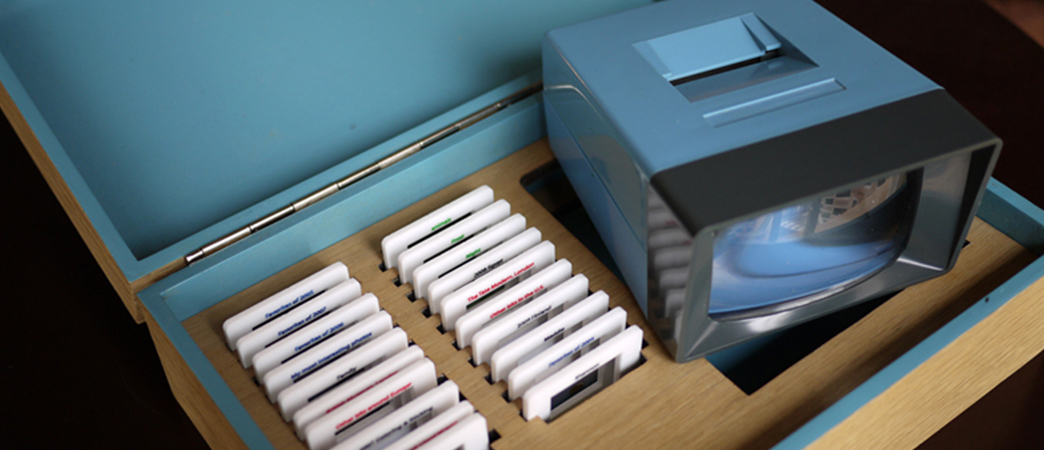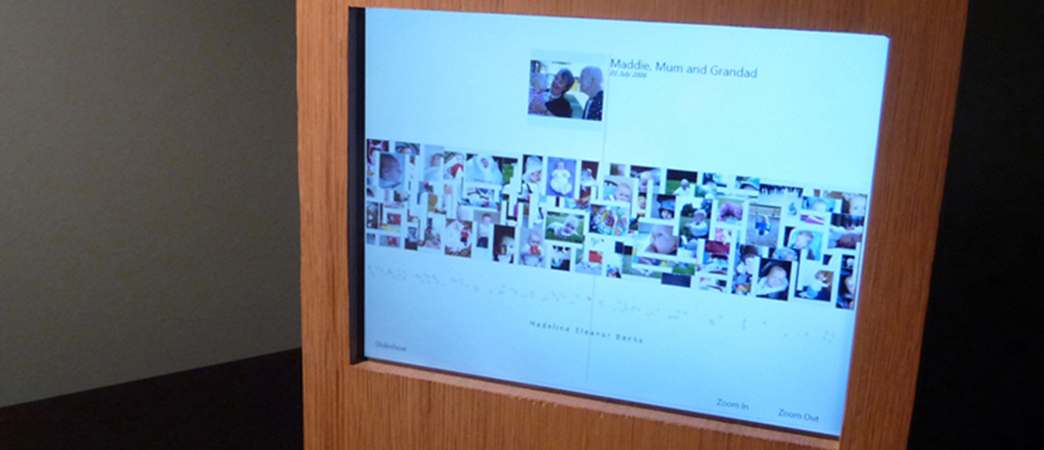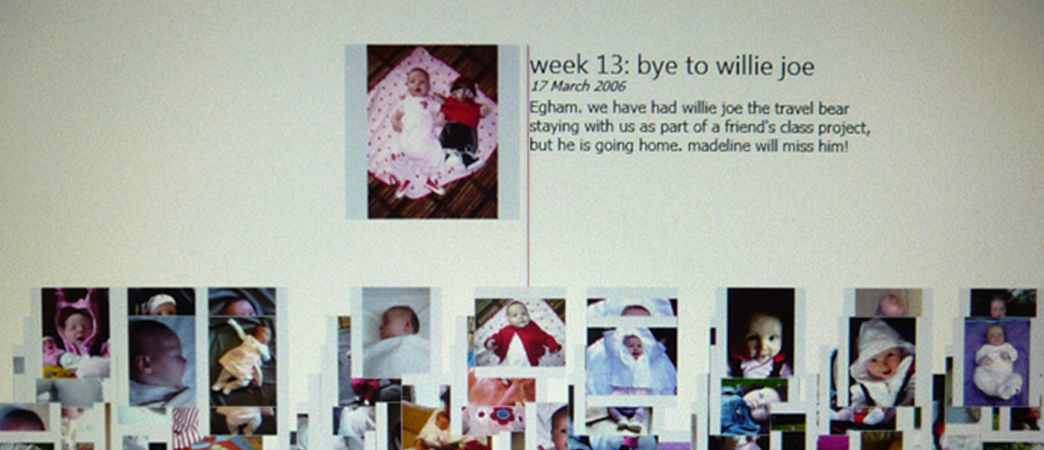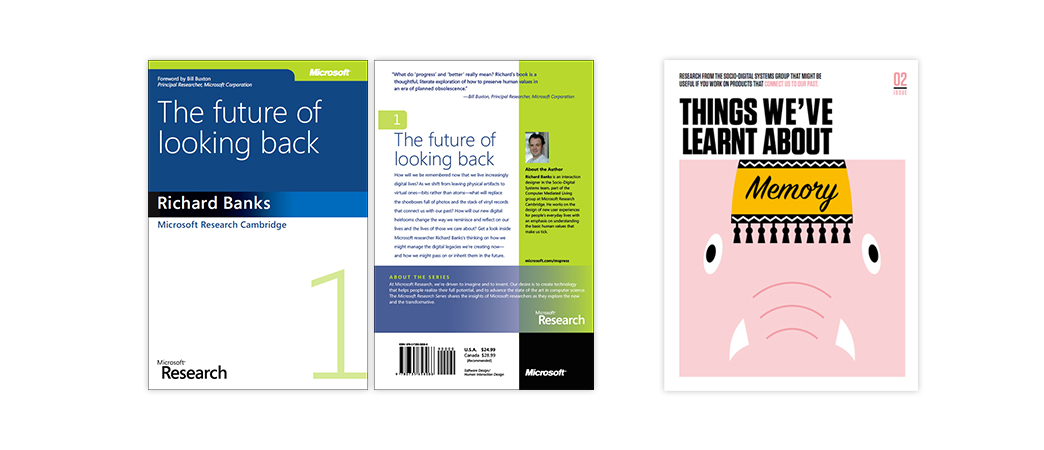While we tend to think of most digital things as only having a shelf life of a few years, the reality is that we’re now taking digital photos, and keeping digital items, for long enough that we have to start thinking about the consequences of using them for reminiscing in the future and passing them on to our offspring. This project explored what it might mean to inherit someone else’s digital as well as physical belongings and it asked how we might use digital technology to reflect on our own lives.

Technology + Time
This idea of thinking about technology over extended lengths of time is a primary motivator for HXD. It seems quite striking how our relationship with technological objects and digital “things” has become quite fleeting. We no longer expect to buy a phone or an mp3 player and keep it more than a few years. We have become used to the idea that something better is just around the corner and are quite prepared to abandon what we have now to get it.
There’s a Green imperative here, of course, as there is in much of what we do now. It seems unsustainable to continue throwing these physical items into landfills, and we either need to change that habit, or find a way of making the cycle less onerous. In Cambridge we’re interested in this ethical dimension, of course, but more broadly we really seek to understand what it means to have an attachment with our things that extends beyond such short periods of time. There are items that we keep and treasure in our homes already, but these tend not to be technological, beyond the odd collection of ancient video games that a few individuals don’t seem to be able to part with. Why do we keep some things, and not others?

The Role of Objects in Our Lives
We are trying to think about this more broadly because our relationship to the things we keep matters not only for physical items, but, we assume, also for the megabytes of data that we’re creating. It is common, for example, to keep and display printed photos in our home. They act as touchstones for us to people and events in our past. They tell visitors to our homes something about us through the choices we make of their content, where they are placed and the prominence they are given. And because these items are physical, their condition tells us something too. They acquire a patina of their own that tell us stories of use. Fingerprints on glass show that attention was paid to them. Nicks and scratches on the frame show how well they were taken care of. So these items help us remember; tell others something about us through our environment; and tell their own story of use as objects.
Is this true of the new digital things in our lives? Is this true, for example, for the thousands of digital photos that many of us are now taking every year? To some extent it may be too early to tell. Our relationship to digital content is still a relatively new one. So part of the work we’re doing in Cambridge is to extrapolate out to try and anticipate how our relationship with digital things will change once we ever get used to having them around over the long term. This is a complex space to design for. It is impossible to predict what items a person will keep and put on display in their home. How can we know what’s likely to be precious to them? An object that seems worthless to one person may be charged with sentiment for another.

The Role of Objects Beyond our Lives
This question of the role of sentiment extends past our own lifetimes, just as the objects themselves are likely to outlive us. What happens to them at the end of our lives? Just as our physical things live on past us, sometimes becoming a part of the lives of our offspring, other family or friends, this will surely be true of our digital items.
The process through which objects are passed on through the generations is complex. Sometimes when we receive things from the deceased it’s through an act that was deliberate and thought out. They intended us to get an item. Sometimes, though, it’s entirely accidental. We may receive heirlooms from them simply through the process of their homes and lives being disassembled.
Sometimes the things that we inherit are welcome, and we’re happy to have them and integrate them into our own lives. We might even put them on display in our own homes. Other times we’re not so happy, and they seem incongruous with the ways in which we live. Maybe we don’t find them attractive, or they’re not very meaningful. Often, even though they are not things we would have chosen to own, they come with a sense of obligation that doesn’t allow us to part with them. We’d rather keep them in a box in the basement than dishonour the memory of the deceased by discarding them. In some senses they are burdensome.
Predicting which heirlooms we might actually feel sentimental about is a challenge. Our parents may THINK that they can predict what we would like to inherit, for example, but often the reality is different. The memories of our own childhood can be quite different from theirs, and therefore the artefacts we feel sentimental about can also be different.
Technology Heirlooms
So the role that inherited items play in the recipients life is complex, as is the job of planning to pass on your own items. We hope, though, to understand something about how this happens in everyday life, and from that learn how this might apply to digital things too.
Beyond that, we also hope to be able to design for heirloom-ness. We are not saying that we can design heirlooms. As mentioned, we cannot predict what may or may not be sentimental to any individual. What we might be able to do, though, is design objects and experiences that help mediate digital content or technological objects in a way that softens their edges, makes content more accessible and so on. This is what we mean by a technology heirloom.
Below are examples of three that we have developed in the course of this project.
Heirloom 1: Timecard
Timecard is a personal timeline object. It’s like a digital photo frame, except the content is structured by time, and is all about one person. You might see a photo on it that you recognize, or you want to use to tell a story to a visitor in your home. Clicking on the photo brings up a timeline view that shows all the photos of that person chronologically. It allows you to see the structure of their life, and tell the story of them in an order that makes sense.
We’re really asking with Timecard if you can build up a personal history of someone to a point where the value of the content and structure accumulates so much that the object become something that a family would come to treasure, and maybe even start passing on through the generations.
Heirloom 2: Backup Box
A lot of the messages we’re sharing through websites like Twitter are a form of diary keeping. Information such as where we are, what we’re doing, who we’re meeting and what we’re thinking, that might traditionally be written in a book at home, is now being shared on line through our status messages and blog entries.
We’re concerned that this content won’t persist long enough online for us to be able to use it for reminiscing once we get older. In 20 or 30 years you might like to be able to use your Twitter feed, for example, to look back on what you were was in 2010. We are not confident, though, that Twitter will still exist in 20 or 30 years, and the onus is thus on you to worry about this since the burden is not on the social networks to persist this content for you for that long.
The Backup Box is a concept device that lives in the corner of your living room doing nothing but backing up the content of your Twitter feed. It’s an object of reassurance that leaves you with some confidence that the message you’re putting online will also persist offline. It’s an insurance policy for the future of your reminiscences.
The Digital Slide Viewer
Imagine you have a relative who uses Flickr for much of their life. One day they pass away. Would you want to inherit their account, with all of its responsibilities, or do you really just want the content to be able to use for reminiscing about the person? We think perhaps the latter.
With the Digital Slide Viewer we imagine that you would be able to pay a service to back up that account into a device which can then live on a bookshelf at home. Like a photo album, you can just pull it down and use it to browse through shots of this person’s life. Those shots just happened to have originated on a web service.
Content actually lives in the viewer. The small white slides correspond to sets of photos (opens in new tab) on Flickr (opens in new tab). When the slides are inserted in the device the colour of the labels on each slide is analyzed, and a corresponding set of images appear on the small screen embedded in the viewer.
This concept was originally developed by Mark Selby (opens in new tab), who interned with us in 2009. He’s now a PhD candidate in Nottingham University’s Horizon Digital Economy Research Hub (opens in new tab).

Some Reading
A couple of follow up publications that may be interesting to read.
The Future of Looking Back (opens in new tab) was published as a book in 2011, authored by Richard Banks. The book is broken down into three broad parts (there’s a pretty extensive preview (opens in new tab) of the content on Amazon). First, in “Stuff and Sentimentality” Richard talks about the difference in nature of physical things versus digital things, and the impact that our transition from the world of real to the world of the virtual might have on the way we preserve and pass on our content. In “A Digital Life” he talks generally about lifespans, and key life events (including bereavement), focusing on the role that technology is starting to play in each, particularly with regard to the creation of personal and sentimental digital artefacts. Finally, in “New Sentimental Things” Richard speculates more on the future and trends in technology and the impact that new directions may have in the way we record, remember and reflect on our past.
The Memory issue of our magazine “Things We’ve Learnt About… (opens in new tab)” also contains some work and thoughts from this projet, and expands into other areas that HXD have explored as a team more broadly.

